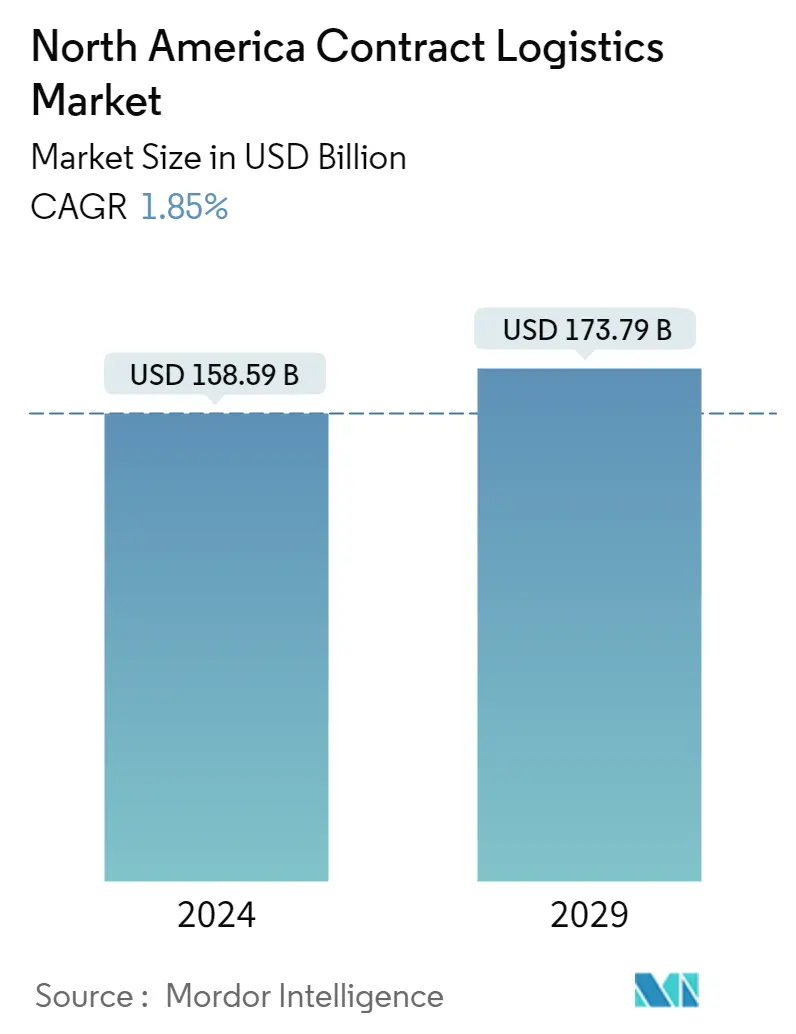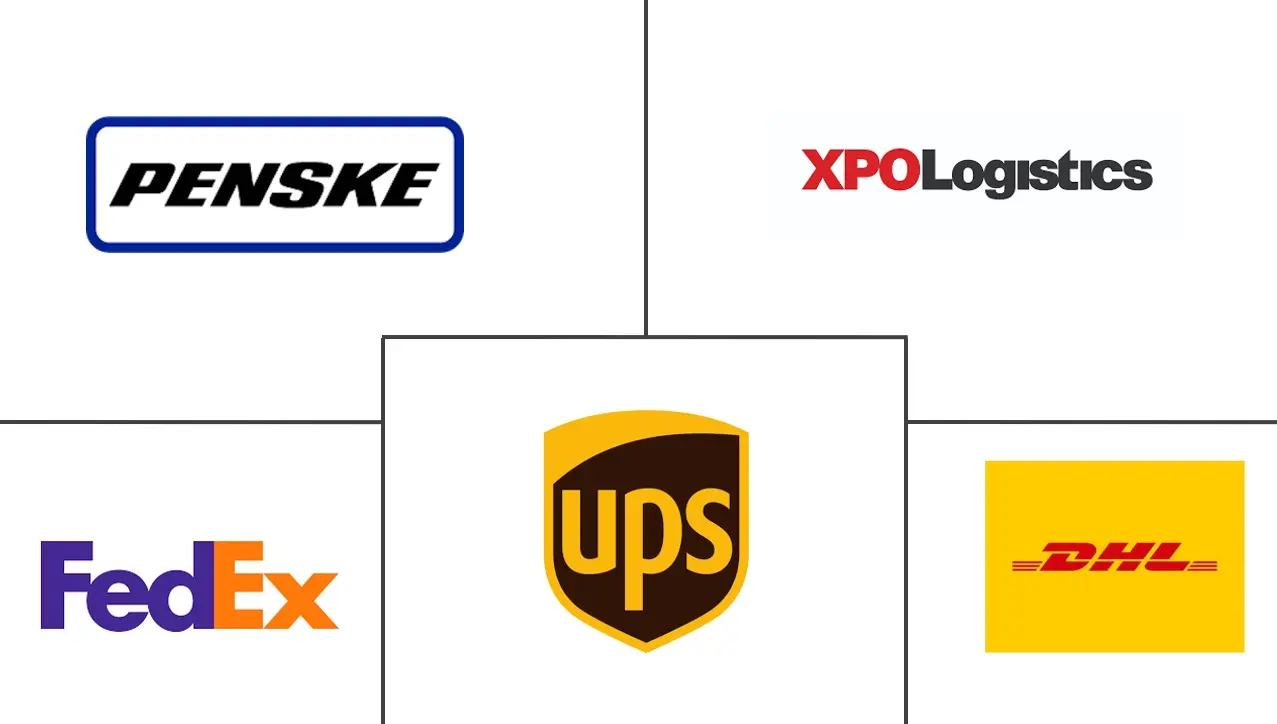Market Size of North America Contract Logistics Industry

| Study Period | 2020 - 2029 |
| Base Year For Estimation | 2023 |
| Market Size (2024) | USD 158.59 Billion |
| Market Size (2029) | USD 173.79 Billion |
| CAGR (2024 - 2029) | 1.85 % |
| Market Concentration | Low |
Major Players
*Disclaimer: Major Players sorted in no particular order |
North America Contract Logistics Market Analysis
The North America Contract Logistics Market size is estimated at USD 158.59 billion in 2024, and is expected to reach USD 173.79 billion by 2029, growing at a CAGR of 1.85% during the forecast period (2024-2029).
- Infrastructure development, digitization, and industrialization are all results of increasing government initiatives for economic diversification. They will probably expand the e-commerce and contract logistics markets, creating a big need for contract logistics services. Several non-asset newcomers are joining current companies as a result of the increase in foreign direct investments (FDIs), the rapid expansion of the e-commerce industry, and the emphasis on risk management in supply chains.
- Additional factors that contribute to market expansion include the manufacturing sector's quick expansion and focus on core competencies, the rising demand for work optimization, achieving cost efficiency, and technological supply chain integrations. The contract logistics industry will not develop because of some constraints and challenges. For instance, managing logistical databases is difficult due to factors including potential misconceptions that lead to inaccurate interpretations of facts, data, and information. Regional disparities and the complexity of the supply chain have a detrimental impact on the process as a whole since there aren't enough experienced people to understand and address problems so that transparency is maintained.
- In 2022, the United States saw a sharp rise in warehouse space rental from regional logistics players in recent years. Retailers are increasingly outsourcing more of their services as a result of rising service requirements like e-commerce and same-day delivery.
- The pandemic's impact on global supply chains put the United States' whole supply chain under unprecedented pressure and exposed long-standing issues with its freight transportation system. Delays and a highly unbalanced flow of products to American ports were caused by interruptions in manufacturing and port closures. More inbound freight arrived at ports as a result of cargo owners switching to "just-incase" inventory plans rather than "just-in-time" methods, which put a strain on storage capacity. The system experienced a significant boost in flow as a result, with each of America's four largest container ports exceeding their prior records and importing over 16% more containers in 2021 than in 2020.
North America Contract Logistics Industry Segmentation
Contract logistics is a long-term partnership that covers various services, from shipping goods or replacement parts to delivering final goods to customers. Every stage of distribution and final delivery is handled by the logistics contract's provider.
The North American Contract Logistics Market is segmented by Type (Outsourced and Insourced), End User (Manufacturing and Automotive, Consumer Goods and Retail, High-Tech, Healthcare and Pharmaceuticals, and Other End Users), and Country. The report offers market size and forecasts in Values (USD billion) for all the above segments.
| By Type | |
| Insourced | |
| Outsourced |
| By End User | |
| Manufacturing and Automotive | |
| Consumer Goods and Retail | |
| High-tech | |
| Healthcare and Pharmaceuticals | |
| Other End Users |
| By Country | |
| United States | |
| Canada | |
| Mexico |
North America Contract Logistics Market Size Summary
The North America contract logistics market is poised for steady growth, driven by factors such as infrastructure development, digitization, and industrialization. These developments are largely fueled by government initiatives aimed at economic diversification, which are expected to bolster the e-commerce and contract logistics sectors. The market is witnessing an influx of non-asset newcomers and increased foreign direct investments, spurred by the rapid expansion of e-commerce and a heightened focus on supply chain risk management. The manufacturing sector's growth, coupled with a demand for work optimization and technological integration in supply chains, further propels market expansion. However, challenges such as managing logistical databases, regional disparities, and a lack of experienced personnel to ensure supply chain transparency pose constraints to the industry's development.
The pandemic has significantly impacted the North American contract logistics landscape, exposing vulnerabilities in the supply chain and prompting shifts in inventory strategies. The United States, in particular, has seen a surge in warehouse space rental and a trend towards outsourcing logistics services to meet rising e-commerce demands. The e-commerce markets in Canada and the United States are expanding, with Canada experiencing the fastest growth in the region. The market is characterized by a fragmented landscape with numerous players, including major companies like DHL, XPO Logistics, UPS, FedEx, and Ryder Systems, competing for market share. These companies are investing in technology and expanding their service offerings to enhance efficiency and meet the evolving needs of the manufacturing and retail sectors.
North America Contract Logistics Market Size - Table of Contents
-
1. MARKET DYNAMICS AND INSIGHTS
-
1.1 Current Market Scenario
-
1.2 Market Dynamics
-
1.2.1 Drivers
-
1.2.2 Restraints
-
1.2.3 Opportunities
-
-
1.3 Industry Attractiveness - Porter's Five Forces Analysis
-
1.4 Value Chain/Supply Chain Analysis
-
1.5 Government Regulations and Initiatives
-
1.6 Technological Trends
-
1.7 Insights into the E-commerce Industry in the Region (Domestic and Cross-border)
-
1.8 Insights into Contract Logistics in the Context of After-Sales/Reverse Logistics
-
1.9 Brief on Different Services Provided by Contract Logistics Players (Integrated Warehousing and Transportation, Supply Chain Services, and Other Value-added Services)
-
1.10 Spotlight - Freight Transportation Costs/Freight Rates
-
1.11 Effect of the Shift from NAFTA to USMCA on the Transport and Logistics Industry
-
1.12 Impact of COVID-19 on the Contract Logistics Market
-
-
2. MARKET SEGMENTATION
-
2.1 By Type
-
2.1.1 Insourced
-
2.1.2 Outsourced
-
-
2.2 By End User
-
2.2.1 Manufacturing and Automotive
-
2.2.2 Consumer Goods and Retail
-
2.2.3 High-tech
-
2.2.4 Healthcare and Pharmaceuticals
-
2.2.5 Other End Users
-
-
2.3 By Country
-
2.3.1 United States
-
2.3.2 Canada
-
2.3.3 Mexico
-
-
North America Contract Logistics Market Size FAQs
How big is the North America Contract Logistics Market?
The North America Contract Logistics Market size is expected to reach USD 158.59 billion in 2024 and grow at a CAGR of 1.85% to reach USD 173.79 billion by 2029.
What is the current North America Contract Logistics Market size?
In 2024, the North America Contract Logistics Market size is expected to reach USD 158.59 billion.

